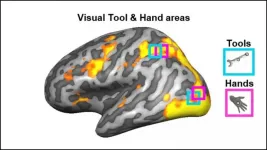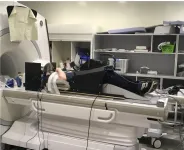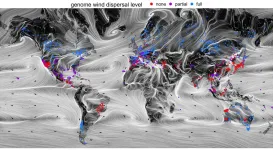INFORMATION:
Informed tourists make whale watching wafer for whales
2021-05-10
(Press-News.org) According to the International Whaling Commission, whale-watching tourism generates more than $2.5 billion a year. After the COVID-19 pandemic, this relatively safe outdoor activity is expected to rebound. Two new studies funded by a collaborative initiative between the Smithsonian Tropical Research Institute (STRI) in Panama and Arizona State University (ASU) show how science can contribute to whale watching practices that ensure the conservation and safety of whales and dolphins.
"The Smithsonian's role is to provide scientific advice to policy makers as they pioneer management strategies to promote whale conservation," said STRI marine biologist, Hector Guzmán, whose previous work led the International Maritime Organization to establish shipping corridors in the Pacific to prevent container ships from colliding with whales along their migration routes. "Now we have methods to measure how whale behavior changes as a result of whale-watching practices. These two papers were published in a special volume of Frontiers in Marine Science dedicated to studies of whale-watching practices worldwide."
Whale watching is on the rise around the world and is part of sustainable tourism-development projects in countries such as Cambodia, Laos, Nicaragua and Panama. But critics say that jobs and increased income for tour operators and coastal residents cannot be justified if whales are harmed.
Whale-watching regulations in Panama first established with Guzman's help in 2005, and modified in 2017 and 2020, prohibit activities that cause whales to change their behavior. The aim of the first study was to discover if the presence of tourism boats caused the whales to change their behavior during the breeding season.
Researchers monitored humpback whales (Megaptera novaeangliae) during their August-September breeding season within Panama's Las Perlas Archipelago protected area. From a high vantage point on Contadora Island and from whale-watching vessels, they recorded the number of tourist boats and whales present and activity, including changes in direction, breaching, slapping the water, dives and spy-hops (raising the head above the water surface) on 47 occasions.
They discovered that whale-watching vessels frequently disregarded legal guidelines designed to protect the whales: deliberately chasing whales, getting too close to adult whales and calves, and forcing whales to change their behavior. Other notable observations included:
Tourist boats chased groups that included calves more often than groups of adults.
Groups that included a calf changed direction more often than did other group types.
Whales changed direction more often when more than two to three tourist boats were present.
Roughly 1,000 whale watchers visit the Las Perlas islands each year, and that number is growing. In the second study, researchers interviewed tourists waiting to return to the mainland at the Contadora airport to better understand the whale watching experience. They interviewed every third person waiting in line.
Ninety-nine percent of the tourists who saw whales reported seeing at least one behavior while whale watching, and 68% reported that their experience met or exceeded their expectations. 30% said that they did not observe a whale. Half reported that they had observed either their boat or other nearby boats chasing whales at high speed, or that they had gotten closer to the whales than the distance permitted by law.
Breeding whales are threatened by marine pollution, ship strikes, climate change, noise and disturbances while they are resting, socializing and feeding. In the future, researchers hope to measure the amount of cortisol (a stress hormone) in whale fecal samples to find out if the animals are under stress, use better technology (e.g., theodolites--instruments that measure angles) to measure the distance between boats and whales, use drones with cameras to document interactions and continue to survey tourists to better understand whale watching and inform management strategies to keep these magnificent animals safe.
"I wanted to do a study with practical outcomes for conservation, not just another paper that sits on a shelf," said Katie Surrey, doctoral candidate at ASU and co-author of both papers. "In Las Perlas, where whales come to breed, we observed harassing behavior, like ten tourist boats surrounding a single mother and calf. But we also talked to tourists and operators who learned a significant amount about whales and champion better whale-watching practices and conservation efforts as a result. For my dissertation I plan to find out more about what motivates both the tourists and the operators, so that we can suggest ways to both improve their experience and safeguard the whales."
ELSE PRESS RELEASES FROM THIS DATE:
For twins, gesture and speech go hand-in-hand in language development
2021-05-10
ATLANTA--Gestures--such as pointing or waving--go hand in hand with a child's first words, and twins lag behind single children in producing and using those gestures, two studies from Georgia State University psychology researchers show.
Twins produce fewer gestures and gesture to fewer objects than other children, said principal researcher Seyda Ozcaliskan, an associate professor in the Department of Psychology. Language use also lags for twins, and language--but not gesture--is also affected by sex, with girls performing better than boys, Ozcaliskan said.
"The implications are fascinating," said Ozcaliskan. ...
UM scientist joins team partnering with UN's initiative to map ungulate migrations
2021-05-10
MISSOULA - University of Montana Professor Mark Hebblewhite has joined an international team of 92 scientists and conservationists to create the first-ever global atlas of ungulate (hoofed mammal) migrations.
Working in partnership with the Convention on the Conservation of Migratory Species of Wild Animals, a U.N. treaty, the Global Initiative on Ungulate Migration (GIUM) launches May 7 with the publication of a commentary in Science titled " END ...
Brain regions involved in vision also encode how to hold tools
2021-05-10
Visual brain areas involved in processing hands also encode information about the correct way to hold tools, according to new research published in JNeurosci.
Each part of the brain's visual system activates in response to a certain type of item -- whether it's faces, tools, objects, or hands. Scientists assumed the brain segregates visual information in this way to optimize motor actions with tools. Yet most studies investigating the brain mechanisms for tool grasping used images of tools or hands, and no actual hand movements were performed.
Knights et al. used fMRI to measure the brain activity of participants as they grasped 3D-printed kitchen tools (spoon, knife, and pizza cutter) and similar-sized non-tools. ...
UEA team reads minds to understand human tool use
2021-05-10
Researchers at the University of East Anglia have made an astonishing discovery about how our brains control our hands.
They used MRI data to study which parts of the brain are used when we handle tools, such as a knives.
They read out the signal from certain brain regions and tried to distinguish when participants handled tools appropriately for use.
Humans have used tools for millions of years, but this research is the first to show that actions such grasping a knife by its handle for cutting are represented by brain areas that also represent images of human hands, our primary 'tool' for interacting with the world.
The research ...
'Unmaking' a move: Correcting motion blur in single-photon images
2021-05-10
Imaging technology has come a long way since the beginning of photography in the mid-19th century. Now, many state-of-the-art cameras for demanding applications rely on mechanisms that are considerably different from those in consumer-oriented devices. One of these cameras employs what is known as "single-photon imaging," which can produce vastly superior results in dark conditions and fast dynamic scenes. But how does single-photon imaging differ from conventional imaging?
When taking a picture with a regular CMOS camera, like the ones on smartphones, ...
Monash study may help boost peptide design
2021-05-10
Peptides " short strings of amino acids" play a vital role in health and industry with a huge range of medical uses including in antibiotics, anti-inflammatory and anti-cancer drugs. They are also used in the cosmetics industry and for enhancing athletic performance. Altering the structure of natural peptides to produce improved compounds is therefore of great interest to scientists and industry. But how the machineries that produce these peptides work still isn't clearly understood.
Associate Professor Max Cryle from Monash University's Biomedicine Discovery Institute (BDI) has revealed a key aspect of peptide machinery in a paper published in Nature Communications today that provides a key to the "Holy Grail" of re-engineering peptides..
The findings will advance his lab's work into ...
Should we panic over declining sperm counts? Harvard researchers say not so fast
2021-05-10
A new study from the Harvard GenderSci Lab in the journal Human Fertility, "The Future of Sperm: A Biovariability Framework for Understanding Global Sperm Count Trends" questions the panic over apparent trends of declining human sperm count.
Recent studies have claimed that sperm counts among men globally, and especially from "Western" countries, are in decline, leading to apocalyptic claims about the possible extinction of the human species.
But the Harvard paper, by Marion Boulicault, Sarah S. Richardson, and colleagues, reanalyzes claims of precipitous human sperm declines, re-evaluating evidence presented in the widely-cited 2017 meta-analysis by Hagai Levine, Shanna ...
As global climate shifts, forests' futures may be caught in the wind
2021-05-10
Berkeley -- Forests' ability to survive and adapt to the disruptions wrought by climate change may depend, in part, on the eddies and swirls of global wind currents, suggests a new study by researchers at the University of California, Berkeley.
Unlike animals, the trees that make up our planet's forests can't uproot and find new terrain if conditions get tough. Instead, many trees produce seeds and pollen that are designed to be carried away by the wind, an adaptation that helps them colonize new territories and maximize how far they can spread their genes.
The ...
Differences between leopards are greater than between brown bears and polar bears
2021-05-10
New research demonstrates that African and Asian leopards are more genetically differentiated from one another than polar bears and brown bears. Indeed, leopards are so different that they ought to be treated as two separate species, according to a team of researchers, among them, scientists from the University of Copenhagen. This new knowledge has important implications for better conserving this big and beautiful, yet widely endangered cat.
No one has any doubts about polar bears and brown bears being distinct species. Leopards, on the other hand, are considered one and the same, a single species, whether of African or Asian ...
Intense light may hold answer to dilemma over heart treatment
2021-05-10
AURORA, Colo. (May 10, 2021) - Looking to safely block a gene linked to factors known to cause heart disease, scientists at the University of Colorado Anschutz Medical Campus may have found a new tool - light.
The study, published Monday in the journal Trends in Molecular Medicine, may solve a medical dilemma that has baffled scientists for years.
The gene, ANGPTL4, regulates fatty lipids in plasma. Scientists have found that people with lower levels of it also have reduced triglycerides and lipids, meaning less risk for cardiovascular disease.
But blocking the gene using antibodies triggered dangerous inflammation in mice. Complicating things further, the gene can also be beneficial in reducing the risk of myocardial ...






